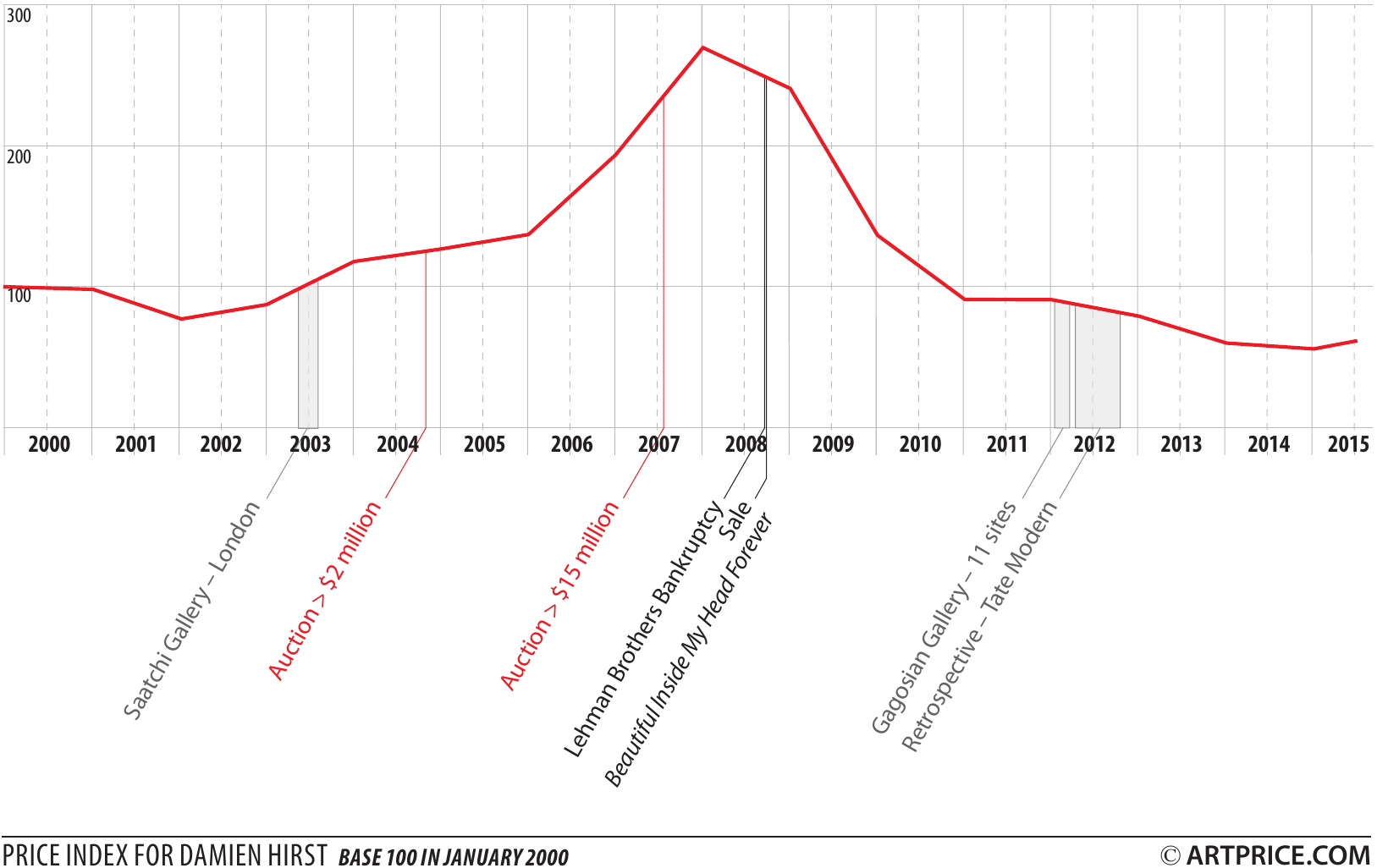Damien HIRST – the enfant terrible in disgrace
Damien HIRST is one of the artists who most benefited from the market euphoria of the 2000s and who has logically suffered the most from its return to sanity in the 2010s. In fact the auction prices of the British enfant terriblehave never recovered: his price index is down -83% since its peak in 2008 and the volume of transactions on his work is down 91%. Here is a brief overview of his tumultuous career, which is still generating controversy.
In 1988, the unknown but clearly inspired Damien HIRST conceived and curated the Freeze show in a London warehouse, bringing together his own works plus those of his friends at Goldsmiths College. At the time, his works and those of Gary HUME, Sarah LUCAS and Fiona RAE had no particular pecuniary value, but the audacious move attracted the attention of the notorious gallery owner and advertising mogul Charles Saatchi. The latter’s mentorial and proselytising expertise, in conjunction with Jay Jopling’s similar skills (White Cube Gallery), projected Damien Hirst to the forefront of the British art scene in record time.
In 1992, year of the Young British Artists exhibition at the Saatchi Gallery, Hirst already epitomised the revolutionary spirit of a new and flamboyant movement that became known as YBA. The following year, he createdMother & Child, Divided (a cow and its calf sectioned and immersed in formalin) for the Venice Biennial, a ‘shock’ installation that earned him the 1995 Turner Prize. In 1997, his notoriety became international with the controversy surrounding the Sensation exhibition at the Royal Academy of Art in London, which attracted 300,000 visitors. His auction results at the time already suggested the emergence of a speculative dynamic: a first medicine cabinet, God (1989), tripled its high estimate when it fetched $315,0001. At that point, Damien HIRST was at the bottom of a bidding tornado that he deftly accelerated with characteristic irreverence.
His dominance of the Contemporary art market reached a high mark in 2007 when he briefly became the most expensive living artist with Lullaby Spring, a large-scale pharmacy cabinet containing 6,136 individually painted pills. The work is one of four that evoke the four seasons while questioning the relationship between art and science – a sort of cabinet of curiosities that classifies, lists and organises colours and pills. It fetched $19.2 million at Sotheby’s, i.e. $12 million more than expected2, and it is to this day his best-ever auction result3. Shortly after that record, Hirst returned to the headlines with a work entitled For The Love Of God, a human skull with 8,601 encrusted diamonds, totalling 1,106.18 carats. Highly controversial, the skull was announced as Hirst’s most expensively produced and most dearly sold work to date4.
At the summit of his glory Hirst decided to take his market into his own hands. With his excellent nose for business, he short-circuited his usual network of galleries, entering into direct contact with collectors via a personal auction sale of 223 works taken straight from his workshop. This historical event5 was organised in collusion with Sotheby’s on 15 and 16 September 2008, just hours after the fateful collapse of Lehman Brothers that precipitated a global financial meltdown. Despite the alarming economic backdrop, the sale was a huge success, generating $147 million with 45 results above the million-dollar line. It also sold his Golden Calf (in formalin) for $18.5 million6. By the end of that exceptional year, the world’s most media-exposed and speculated artist had generated more annual auction turnover that any of the great Modern masters like Claude Monet or Alberto GIACOMETTI…
Just months later, the global art market started to contract and the first to feel the pinch were those who had soared too high too fast. Between 2008 and 2014, Damien HIRST’s annual auction turnover collapsed and he fell from 4th place to 108th place in the global ranking7. At the same time, his unsold rate rose sharply from less than 15% to 35% and a number of his major works failed to sell despite price estimates lower than his results at the start of the 2000s. Meanwhile, art critics began to express a certain disaffection towards Hirst and his work as a whole, portraying him as a manipulator of the art market.
Damien HIRST’s auction career is perhaps the best example of negative rebound from excess speculation. Take for example Lullaby Spring, the work that fetched $19.2 million in 2007. Its twin sister, Lullaby Winter8 sold in February 2015 for $4.6 million, within its pre-sale estimated range. This suggests that Lullaby Spring would, if sold today, lose $14.6 million of its 2007 value!

However, speculation is not the only problem Damien HIRST’s market has encountered. Two other factors have also had a negative impact: the accelerated ageing of his works, and over-production. Regarding the former, examples are the varnish used in his Spot Paintings which has cracked over time on overly flexible canvases; the animals immersed in formalin have decomposed faster than anticipated; the butterflies glued to painted surfaces are by nature extremely fragile… In short, his use of unstable materials has led to insurance difficulties and disappointed collectors, and the rapid deterioration of certain works has understandably had a dampening effect on the acquisition of artworks with such high prices.
Regarding the second problem, Hirst has been accused of over-producing to satisfy the market. Aged 50 in 2015, Hirst has produced no less than 1,365Spot paintings that have saturated the market, inducing a certain indifference among collectors and somewhat tarnishing his image. For some, Damien HIRST has become an outmoded fashion label. In short, his fans are feeling overwhelmed, speculators have gone elsewhere and sale requests are today more common than acquisition requests.
But Damien HIRST has not fired his last shot and is pursuing his self-promotion in a new way. He has just opened his own gallery in London’s administrative district of Lambeth to install his own remarkable collection, including works by Jeff KOONS, Sarah LUCAS, Tracey Emin, Pablo PICASSO and Francis Bacon. The new gallery has recuperated a little of the market control that appeals to the business side of Britain’s most notorious living artist.
- Christie’s London, 22 April 1998.
- London, 21 June 2006.
- In dollars, Lullaby Spring remains his best result. In pounds sterling, it was however beaten by the sale of The Golden Calf for £9,652,000 including fees at Sotheby’s in London in 2008.
- The White Cube Gallery apparently sold it for $100 million in August 2007.
- Titled Beautiful Inside My Head Forever.
-
The Golden Calf, 2009.
- Damien HIRST’s annual auction turnover fell from $230 million to $18.8 million excluding fees.
- A work of the same size, from the same series.






 41.9
41.9
